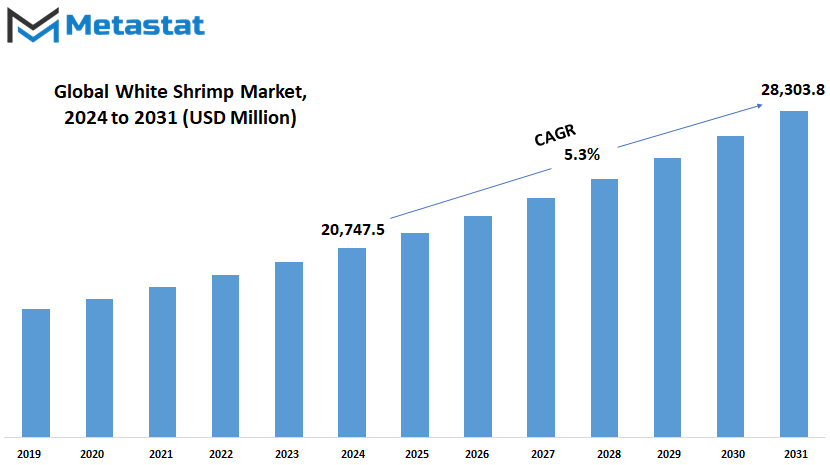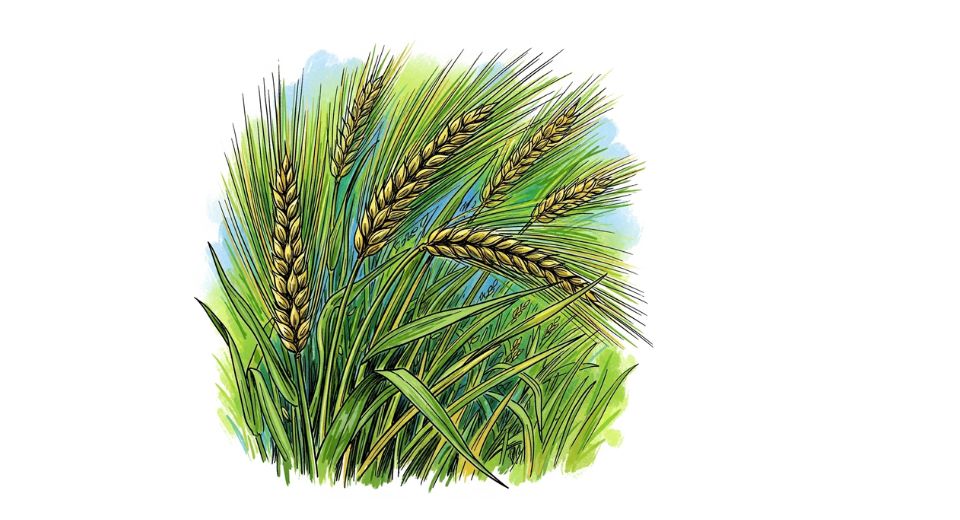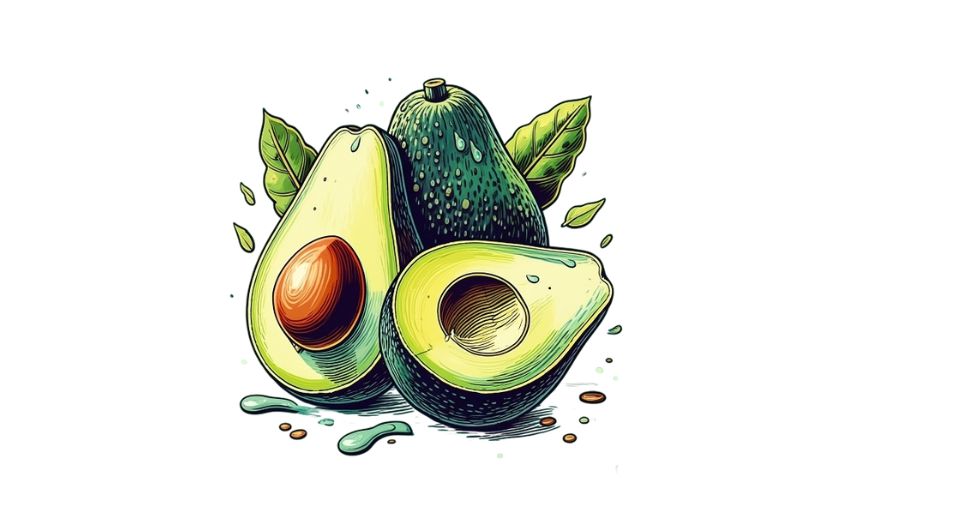MARKET OVERVIEW
The Global White Shrimp market and its industry take up a significant share within the seafood sector and represents one of the world's essential sources of nutrition and value-added contributions worldwide. Litopenaeus vannamei, popularly known as white shrimp, tops the list in the category of aquaculture farmed shrimp widely consumed globally. It covers areas and aquaculture productions, wild catches, processing, distribution, and trade for white shrimp, thus incorporating the white shrimp in the global seafood chain. With its wide diversity and increasing demand, it remains a dynamic sector due to changes in consumption pattern and advancement in aquaculture technologies.
The Global White Shrimp market is a large, integrated system that connects producers and consumers through the links of shrimp farmers, exporters, importers, food processors, and retailers. Shrimps are mainly produced in coastal aquaculture farms, mainly in Asia, Latin America, and the United States. These three regions are major producers since the climatic conditions, available resources, and developed farming practices are more accessible to them.
The white shrimp is tolerant to the widest possible range of salinity. It has the potential for rapid growth. Therefore, using this species represents an excellent trend in aquaculture. Such a trend will surely have a steady supply chain meeting an increasing global demand. With more increased reaches, international trade will create diversified global white shrimp markets thereby serving a great number of the segments ranging from food services retailing to processed food industries. Frozen and fresh white shrimps will remain widely acceptable products. The value added items such as breaded shrimp, pre-cooked options, and ready to-eat versions are likely going to be in great demands.
Increasing demand among consumers for convenient food options results in the involvement of producers in new types of packaging as well as preservatives extending shelf life with quality that is not sacrificed. This will push the market even more for its shares in the white shrimp aquaculture worldwide. As of now, Asia Pacific leads the way for White Shrimp on the international market, which has such massive aquaculture activities in India, China, Thailand, and Vietnam. Regions such as North America and Europe will also emerge as important markets eventually, since consumers are becoming more educated about the nutritional quality of seafood and how it can be included in a large portion of diets.
Well-established distribution networks and the betterment of cold chain logistics will facilitate easy transport from production centers to consumption hubs across continents. Sustainability and traceability have been projected to be the salient themes that will help shape the Global White Shrimp market in the coming years. Its adaptation to changing market trends and acceptance of sustainable practice will assure its sustainability and growth over time. Its growing demand for good-quality seafood from all around the world means that it will be one of the essential contributors to global food security and economic development in the years ahead.
Global White Shrimp market is estimated to reach $28,303.8 Million by 2031; growing at a CAGR of 5.3% from 2024 to 2031.

GROWTH FACTORS
In the past few years, Global White Shrimp market has seen immense momentum, and this trend is expected to continue ahead in the future due to a variety of major driving factors. The key driving factor for this sector is the rise in demand for healthy protein-rich seafood options all over the world. Since people have started becoming increasingly health-conscious, there has been a notable shift toward protein sources that are nutritious and, additionally, possess health benefits. White shrimp is gaining popularity due to the low fat and high protein content of the white shrimp, and its ease in preparation in various cuisines. Demand for white shrimp is being driven by increasing acceptance of seafood with increasing awareness of nutritional values in various regions. White shrimp are in great demand. Aquaculture expansion remains one of the main causes of market increase.
Increasingly, aquaculture is stepping up to fill the gaps left behind by wild shrimp from overfishing. Shrimp farming or aquaculture has facilitated more stable supplies and supplies of white shrimp. Advances in farming technologies and techniques have improved the efficiency of shrimp production, further supporting market growth. This ability to be produced in high volumes and on an ongoing basis makes it more attractive to seafood producers, retailers, and consumers in general. However, despite the potential for growth within the Global White Shrimp market, there are threats that could impact its continued growth. Environmental issues and regulations on shrimp farm operations are the greatest constraints.
Shrimp farming sometimes leads to environmental degradation through water pollution and habitat destruction if not properly managed. Governments and environmental bodies are now keen on formulating regulations to control these negative impacts. The laws may be necessary in safeguarding ecosystems; however, they do augment the cost and add complications to shrimp farming enterprises; as such, they have an effect of limiting further development of the market. The second weakness of shrimp farming involves diseases, which contribute to loss in yields. Different kinds of diseases affect shrimp farming such as white spot syndrome which may cause a massive destruction to the shrimp population and can also result in supply shortages as well as instability in markets. This will force the farmer to find different ways on preventing and controlling diseases but it might still strike the industry and hence slowing the rate of growth. These futures in store for this market look promising.
Innovations and also in eco-friendly farm technology are going to be great players in overcoming most challenges facing this shrimp-farming industry. New environmentally conscious nature of a consumer as well as producers will contribute to raising in this market in pursuit of this greener future. These developments would not only benefit the environment but also ensure that shrimp farming is more sustainable and resilient, hence assuring the market to remain healthy in the future.
MARKET SEGMENTATION
By Type
Rapid market growth is being observed because consumers' demand for seafood keeps rising, and the growing world population further fuels this sector, ensuring a continuous change as its requirement evolves with consumer trends all around the world. Several different kinds of shrimp products make up this market, and there are two primary ways it categorizes such product lines: based on available kinds of shrimp. The most commonly consumed varieties of white shrimp are Fresh White Shrimp, Frozen White Shrimp, and Processed White Shrimp. These categories cater to different demands from consumers and are bound to define the future course of the market. Fresh White Shrimp is very much in demand by those consumers who prefer the taste, texture, and freshness in seafood as a whole.
These shrimps are liked much in restaurants and gourmet kitchens for their quality to provide a nice dining experience. Fresh White Shrimp are going to be in even higher demand as people move ahead in their pursuit for fresh and healthy food products. The technology behind shipping, as well as more efficient supply chains, makes fresh seafood transportation easier across a long distance. As such, this will help in enabling consumers in other regions where fresh shrimp is not readily available in the markets to enjoy this product. Frozen White Shrimp provides for ease of availability and shelf life in contrast to fresh shrimp.
With improving freezing techniques, consumers will be able to enjoy shrimp at their own convenience without sacrificing quality. Processed White Shrimp are becoming increasingly popular as these are commonly used in a variety of prepared dishes and snacks. The products are generally peeled, deveined, and sometimes marinated or seasoned to suit specific consumer demands. With the popularity of processed foods, the processed shrimp market is expected to grow. Convenience and the increasing demand for ready-to-eat or easy-to-cook options are partly driving this shift in both households and foodservice sectors. Each of the product types mentioned above will further evolve into its own innovation in the future.
The development of aquaculture, shipping, and processing-related technologies shall be a very important contributor to the ensuring of adequate supply of quality shrimp to complement the demand. These consumer preferences are going to continue their influence on the marketing and packaging of shrimp and so on, and so forth in driving the growth of these various product categories in the different markets. This trend, along with growing concerns on the environment and sustainability, is probably going to adapt into the shrimp industry. Thus, it will keep the market in a strong position, both resilient and sustainable for the long run.
By Farm Type
The Global White Shrimp market is an integral part of the global seafood industry. Several factors influence its growth into the future. As shrimp continues to be in rising demand, it becomes critical to understand the two main farm types: wild-caught and farmed white shrimp. Both types play a pivotal role in shaping the market, and the trend will continue to evolve in the years ahead.
Wild-caught white shrimp, obtained directly from oceans and seas, have been a favorite for years in global seafood markets. The appeal of wild-caught shrimp is based on their natural, free-range habitat, which many consumers associate with better taste and quality. However, the challenges associated with wild-caught shrimp are growing, especially overfishing and sustainability concerns.
Those considerations may move the industry toward more restrained, controlled harvesting in an attempt to ensure its own longer term viability. Climate changes and variation will affect wild white shrimp availability, thereby also adding price or uncertainty effects from supply. The latter again make effective management and collaboration among the global actors fundamental issues for the management of wild-caught white shrimp as part of the future segment. On the other hand, farmed white shrimp have become popular due to improvements in aquaculture technologies.
These are farmed in controlled environments such as ponds or tanks, which provide supply chains that are more predictable than those of their wild counterparts. In the years leading up to the present day, practices in shrimp farming have evolved to emphasize both productivity and sustainability. This trend is likely to continue, as new developments in feed, water quality management, and disease control will continue to make shrimp farming more efficient and environmentally friendly.
In the near future, consumers are expected to become more conscious of sustainable seafood choices, leading to a significant expansion in the farmed white shrimp market. With population growth and the continuing demand for affordable protein sources, farmed white shrimp will continue to make up an increasingly bigger share of the market. In the future, the Global White Shrimp market will thus be influenced by the trend of balancing wild-caught and farmed shrimp.
Since environmental sustainability is a future priority for consumers and their governments, farming will more than likely become even more sophisticated in meeting this increased demand while minimizing ecological impacts.
On the other hand, wild-caught shrimp are likely to see a transition toward sustainable and regulated fishing. How the market will take shape in the coming years is going to depend on how these developments progress in both sectors, making for an exciting landscape both for the producers and consumers.
By End-User
The white shrimp market is on the growth trajectory because the global demand for this popular seafood product continues to expand various industries. Consumer preference is a significant reason for this, which tends to favor a healthier and protein-rich diet. The future of this market seems promising with various sectors contributing to its growth. The white shrimp market is divided into end-user categories: retail, foodservice, and industrial use. This divides the market into different groups. Retail is one of the major sectors in the white shrimp market.
Because consumers have become more concerned with nutritional benefits of shrimps, retailers strive to be able to respond to these demands. The product of shrimp is often found in supermarkets and grocery stores as frozen, fresh, or processed. White shrimp is likely to remain one of the popular products with the retail stores, hence expanding the demand base among health-conscious consumers worldwide. Retail, as a market segment, would witness steady growth. The white shrimp market is expected to grow by leaps and bounds in the foodservice segment.
Restaurants, cafes, among others, have included shrimp within their offerings for years due to the variety in customers' interests. With consumers becoming ever more interested in the seafood, especially in fast-casual and fine dining, foodservice has much to play in the actualization of the market trend. Markets for white shrimp within the foodservice will then proliferate as more restaurants consider themselves capable of serving up high-end, healthy plates that adapt their menus into placing shrimp in a plethora of dishes, from starters all the way to mains.
The growing trend toward healthier eating habits, mainly in regions like North America and Europe, will further increase demand for shrimp-based menu items and, consequently, the product. In industrial use, the global market for white shrimp is also expanding. Shrimp is used in many industrial applications, such as the manufacture of shrimp-based products such as sauces, soups, and other processed foods.
Shrimp is increasingly being adopted in pet food, especially to produce high-quality and nutritious foods for animals. With a growing global population, demand for shrimp-based products in industrial applications will increase, further propelling the growth of the market. The white shrimp market is a bright future ahead, as diverse sectors like retail, foodservice, and industrial use are leading the markets. Each of these segments will continue to grow because of changing consumer preferences toward healthy eating and sustainable sources of seafood. This is sure to impact the global white shrimp market in the coming years with growing opportunities in all sectors.
By Distribution Channel
The global market for white shrimp is growing considerably due to the increasing demand from consumers for seafood, specifically white shrimp. This pattern is expected to continue into the future as shrimp is becoming a staple in most diets globally. The way shrimp reaches the end consumer involves the market's distribution channels. These channels will continue to evolve with changes in consumer behavior, technological improvements, and economic changes.
The direct sales to retailers would increase in the coming years, as retailers are distributors. They provide both fresh and frozen shrimp to the final consumers. With increasing desire for convenience, they can rely more on direct sale, thus having a large volume of inventory and maintaining stable supply of white shrimp to consumers. This shift will be expected to cater for the increased demand for the speedy and easy access to seafood, especially in towns where people lead busier lives. Besides, as the retailers improve their supply chain operations, they will make shrimp available at competitive prices to both the consumer and the market in general.
Wholesale and distributor channels will be vital, especially in reaching a wider section of people. Most of the shrimp wholesalers sell their products in bulk quantities and supply various foodservice places, including restaurants and grocery chains. As the white shrimp demand increases globally, wholesalers and distributors will need to streamline their operations to keep the supply chain smooth. These channels will adapt through more efficient logistics, focus on sustainability, and utilization of digital tools to trace shrimp movement from farms to markets. Due to increased seafood consumption around the world, wholesalers will probably be a vital link to deliver shrimp to the food industry.
Online sales also emerge as a channel gaining speed in the global white shrimp market. With e-commerce emerging, consumers are purchasing increasing amounts of food, including shrimp, from these websites. This is the direction that will be expected in the future with increasing specialized online seafood suppliers. This channel will be even more popular because consumers will be able to buy shrimp from the comfort of their homes, with the option for home delivery. With time, technological innovations like better packaging and faster shipping will ensure that white shrimp reaches consumers fresh and in prime condition.
Foodservice distribution channels, restaurants, and catering services will continue to be among the biggest channels for white shrimp markets. The globalization of a middle class is changing the way people consume food. In the short term, there will be higher demand for quality seafood served in foodservice establishments. In the future, streamlined operations, better sourcing strategy, and sustainability will come into play to ensure availability of fresh shrimp in ample quantities.
As the white shrimp market continues to evolve across the globe, all of these distribution channels will adapt according to consumer needs while allowing for the long-term sustainability of the market. Demand will grow, and the consumers will change their preferences; each channel will play an important role in shaping the future of the shrimp industry.
|
Forecast Period |
2024-2031 |
|
Market Size in 2024 |
$20,747.5 million |
|
Market Size by 2031 |
$28,303.8 Million |
|
Growth Rate from 2024 to 2031 |
5.3% |
|
Base Year |
2022 |
|
Regions Covered |
North America, Europe, Asia-Pacific Green, South America, Middle East & Africa |
REGIONAL ANALYSIS
The White Shrimp market around the world is, however, expanding considerably driven by the growth in white shrimp products consumption around different locations. Geographically, it can be categorized into multiple regions, which include North America, Europe, Asia-Pacific, South America and Middle East & Africa; all these are key entities shaping the future of White Shrimp.
North America, which is composed of the U.S., Canada, and Mexico, is an important player in the international market for White Shrimp. The U.S. especially has high consumption of shrimp and a growing interest of consumers in sustainable and responsible seafood. This demand will further be fueled by health consciousness among the population due to shrimp being a protein-rich food. In Canada and Mexico, domestic consumption as well as exportable markets are driving the expansion of the shrimp industry. During the next few years, the North American market will continue to grow; technology in shrimp farming and processing will support this development.
The European market refers to the UK, Germany, France, Italy, and other countries. White Shrimp has a great potential market in Europe - a mature market. The demand for shrimp in this region is mainly driven by its high demand as a premium food product. As European consumers continue to become more conscious of the environmental impact of their food choices, there will be a growing demand for sustainably farmed shrimp. This trend will shift the market toward more environmentally friendly production methods, such as aquaculture techniques that minimize environmental damage. Also, European countries are seeking diversification of sources for shrimps to avoid import dependence on some countries. In the coming years, it will open up an avenue for the market to expand.
The Asia-Pacific region, which includes the important markets of China, India, Japan, South Korea, and others, will be the largest market for White Shrimp. Increased seafood consumption is significantly driven by Asia's growing middle class and rising disposable income. Shrimp farming in such countries as China and India is becoming more advanced and technological improvements result in higher yields and efficient production. The long coastline and warm climate in the region are ideal for large-scale shrimp farming. With increased investments in aquaculture, Asia-Pacific will continue to dominate the global White Shrimp market in the future.
The White Shrimp market is also growing in South America, especially in Brazil and Argentina. The region, with its ideal climatic conditions for the farming of shrimp, further enhances production at low cost, a reason for great appeal from both local consumers and external markets. Therefore, among the leading exporter countries for shrimp, Brazil will dominate the market by setting trends of the global marketplace. Indeed, in South America, sustainable practices about shrimp farming will become vital with ever-increasing concerns over environmental issues.
Middle East & Africa is a region with significant interest in the White Shrimp market; it consists of GCC countries, Egypt, South Africa, and other regions. While the share in the regional market remains small, growth is predicted because of rising demand for quality seafood in the region. Expansion in shrimp farming in countries like Egypt will be one of the positive factors that will support the market growth. Furthermore, due to the rising investments made in the food production infrastructure of the region, the future of the market looks bright in the Middle East & Africa.
The White Shrimp market will grow worldwide as consumer demand increases, production efficiency improves through technological advancement, and sustainability becomes a central focus for the industry. Each region will uniquely contribute to shaping the future of this market, driven by local dynamics and global trends.

COMPETITIVE PLAYERS
The global white shrimp market is very dynamic and competitive in terms of the existence of diverse players who continue to influence its future. Due to the increasing demand for white shrimp, a few companies are positioning themselves at the forefront of this industry in unique ways that ensure this growing consumer appetite. This market is driven by the developments in aquaculture, improved technology, and awareness of the health benefits linked to seafood consumption. The combination of these factors continues to make the major players strive to enhance their share in the market and provide innovative solutions for the evolving needs of consumers around the world.
Some of the key players in the white shrimp industry include Thai Union Group, one of the leading seafood companies globally. Their strong supply chain and vast distribution network give them an edge in maintaining a robust presence in the market. Similarly, Avanti Feeds Limited plays a crucial role in the development and supply of quality shrimp products. With a focus on sustainability and the future of aquaculture, the company is continually innovating to maintain its competitive position.
Charoen Pokphand Foods PCL is another leading name in the industry, with an extensive operational footprint that extends across several countries. Shrimp farming and processing remain their core competencies; hence, they are strategically positioned to meet the demand for white shrimp across the regions. Coastal Feeds and GROBEST specialize in feed products and remain part of the shrimp production chain, ensuring optimal growth and yield for farms.
NOAA Fisheries is an important player, providing necessary oversight and regulation to ensure sustainable practices in shrimp farming. With sustainability becoming the major concern of consumers, companies like Visual Foods Limited and SEAFOOD INDIA are responding by adopting more eco-friendly practices that reduce the environmental impact of shrimp farming.
Some other significant contributors to the white shrimp market are Jeelani Marine and Apex Frozen Foods Ltd., which pay great attention to quality product and innovative production techniques. Brands like Allen Brothers, Aqua Star, and Carson & Company, in frozen seafood, are premium offerings for retail and foodservice sectors and continually adapt their offerings to change consumer preference.
Other notable players in the list include Mazzetta Company, DEVA EXPORTS, and Sea Port Products. Quality and consistency in their products keep them ahead in competition. In the near future, when the market becomes even more dynamic, the same players will also try to evolve with improved offers and more extended penetration across the white shrimp market worldwide. Looking to the future, it is clear that these key players will remain central to the market's growth and development, responding to trends like sustainability, consumer demand for healthier foods, and the ongoing push for efficient production practices.
White Shrimp Market Key Segments:
By Type
- Fresh White Shrimp
- Frozen White Shrimp
- Processed White Shrimp
By Farm Type
- Wild-Caught White Shrimp
- Farmed White Shrimp
By End-User
- Retail
- Foodservice
- Industrial Use
By Distribution Channel
- Direct Sales to Retailers
- Wholesale and Distributors
- Online Sales
- Foodservice Distribution
Key Global White Shrimp Industry Players
- Thai Union Group
- Avanti Feeds Limited
- Charoen Pokphand Foods PCL
- Coastal Feeds
- GROBEST
- NOAA Fisheries
- Visual Foods Limited
- SEAFOOD INDIA
- Jeelani Marine.
- Apex Frozen Foods Ltd.
- Allen Brothers
- Aqua Star
- Carson & Company
- Mazzetta Company
- DEVA EXPORTS
- Sea Port Products
WHAT REPORT PROVIDES
- Full in-depth analysis of the parent Industry
- Important changes in market and its dynamics
- Segmentation details of the market
- Former, on-going, and projected market analysis in terms of volume and value
- Assessment of niche industry developments
- Market share analysis
- Key strategies of major players
- Emerging segments and regional growth potential








 US: +1 3023308252
US: +1 3023308252






